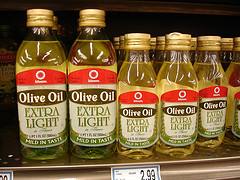New USDA Rules Seek To End Olive Oil Confusion
While the rest of the federal government seems to be wrapped up in cleaning up the BP oil spill in the Gulf of Mexico, the Dept. of Agriculture has had its laser beams set on oil from a different source — olives.
Attempting to separate the wheat from the chaff in the glutted and confusing olive oil market, the USDA has adopted actual standards and definitions for what makes a particular olive oil “virgin,” “extra virgin” or any number of other terms that get thrown about loosely by oil manufacturers.
The new standards, which will go into effect in October, come after the California Olive Oil Council, a trade association responsible for most U.S.-produced olive oil, recently adopted its own scientifically verifiable standards.
Says the exec. director of the COOC:
It will put an end to marketing terms that are confusing to the consumer, such as light, extra light — language that really doesn’t meant too much…
There has been a concern for some time about the quality and truthfulness of oil brought into the United States… In the absence of a federal standards, some unscrupulous importers have flooded the market.
Some smaller olive oil producers are thrilled with the new regulations. By having an official set of standards, the consumer will have more to go on when buying a brand of olive oil than just the label.
“Now it’ll be a level playing field,” one producer said of the new regulations. “I’ll still put out the same product, but I won’t have to compete with garbage that’s out there.”
USDA gets picky over what makes olive oil ‘extra virgin’ [USA Today]
Want more consumer news? Visit our parent organization, Consumer Reports, for the latest on scams, recalls, and other consumer issues.


